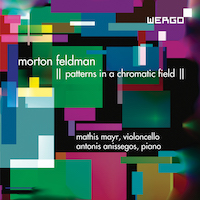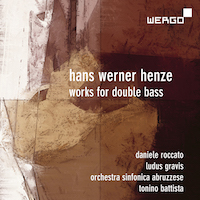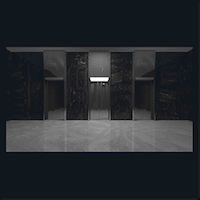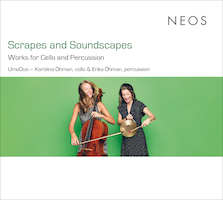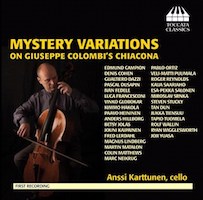String Theory 33: Mostly Cellos and Basses
|
Grant Chu Covell [November 2020.]
Morton FELDMAN: Patterns in a Chromatic Field (1981). Mathis Mayr (vlc), Antonis Anissegos (pno). Wergo WER 7382 2 (1 CD) (en.schott-music.com/wergo). The boldest surprise in Patterns in a Chromatic Field is how after ten minutes, plus or minus, the activity level plummets. The opening is brusque, perhaps assertive for Feldman. Nearing 30 minutes, we strain to inventory the cello and piano interplay: sparse pitches, subtle rhythmic twists, quick repetitions clouded in silence. A lengthy section built from just two pitches does not feel minimal. When the duo returns to hustle, the effect is violent in its suddenness and registral contrasts. There is plenty to recognize upon recurrences, including meek surprises and piano lines suggesting Palais de Mari. The notes provide Meghann Wilhoite’s helpful aural clues clocked against the performance’s entire duration (1:19:42). However, this release is divided into seven unequally sized continents. I’m not sure how many Feldmaniacs will trouble with the prerequisite math. Wilhoite reminds that Feldman often spelled pitches unexpectedly: an E-flat may be followed with a C-double-sharp. The cellist might contemplate slight microtonal shifts not always appreciable on a recording. Mayr and Anissegos are recorded closely. The piano is not particularly loud, but internal resonance is diligently captured. With Chopin no one wants to hear an echo, but for Feldman it pays to be reminded of interacting wood, metal and felt.
Hans Werner HENZE: San Biagio 9 Agosto ore 12.07 (1977)1; Concerto per contrabbasso ed orchestra (1966)2; Serenade (1949; arr. Lucas DREW, 1981)3; Trauer-Ode (1997; arr. Daniele ROCCATO, 2010)4. Daniele Roccato1,2,3 (cbs), Orchestra Sinfonica Abruzzese2, Tonino Battista2 (cond.), Ludus Gravis4: Daniele Roccato, Francesco Platoni, Alessandro Schillaci, Stefano Battaglia, Giacomo Piermatti, Paolo Di Gironimo (cbs). Wergo WER 7391 2 (1 CD) (en.schott-music.com/wergo). Bassist Roccato ably conveys us through Henze’s tricky liquidity. On this program, the solo melancholic trifle San Biagio 9 Agosto ore 12.07 precedes the infrequent Concerto. Exemplifying a less enduring serial style, the interplay between soloist and orchestra marries Schoenberg’s brittle pointillism with Berg’s comfortable Romanticism. Balance proves tricky in the central Vivace where the agile bassist must navigate timpani, plucked strings and brass fanfares. This esoteric Concerto makes its challenges evident but doesn’t satisfy a listener as readily as the solo pieces. Originally for single cello, the Serenade collects nine short movements, some bright (II: Un poco allegretto, V: Vivace) some morose (IV: Andante con moto, IX: Menuett). The Trauer-Ode is also a transcription, here lusciously revealed by six basses. Late Henze appears to have drifted towards Richard Strauss.
“For this from that will be filled.” Clarice JENSEN and Jóhann JÓHANNSSON: bc (2017). Michael HARRISON: Cello Constellations (2017). Clarice JENSEN: For this from that will be filled (a) (2017); For this from that will be filled (b) (2017). Clarice Jensen (vlc). Miasmah Recordings MIA 041 (1 LP or 1 CD) (www.miasmah.com). Here’s a drone variety pack. Jensen’s two pieces, For this from that will be filled, perhaps parts or variations, disclose contrasting approaches to arpeggios, looping layers and intruding mechanical noise (a field recording from Grand Central Station, NYC). Her two works, one short, one long, start and finish in different places. The solo cello’s activity is readily apparent. The initial performances included Jonathan Turner’s video projections. Harrison’s Cello Constellations enacts a precise plan involving solo cello, 14 pre-recorded cellos and sine tones. Pitch and duration are determined through a proportional series which elicits interacting microtones. The phasing unfolds in 15 minutes as patterns appear and fall away. Jensen and Jóhannsson’s collaboration, bc, cleverly disguises an ascending scale and looping chords to inhabit a cozy, echoing space.
“Scrapes and Soundscapes.” André CHINI: Gina et Fio (2014). Jenny HETTNE: Bells and Tides (2016). Ricardo ELZIRIK: re / wind / re / write – fast-forward version (2014). Esaias JÄRNEGARD: Stenar – Aska, aska (2011). Leilei TIAN: Never-Ending Journey (2016). Ivo NILSSON: Whereabout I (2017). Farangis NURULLA-KHOJA: Se… (2018). UmeDuo: Karolina Öhman (vlc), Erika Öhman (perc). Neos 12001 (1 CD) (www.neos-music.com). These Swedish sisters shape a flexible cello and percussion duo. In most of these pieces things strung and struck form a composite instrument. Gina et Fio feels most like a duo given the recurring call and response, as does the short and mysterious Se…. But most of these works ask the cello to explore less familiar noises. Re / wind / re / write suggests a deteriorating clock mechanism. Stenar – Aska, aska turns inward and has the cello imitating a squeaking door. Accompanied by drums, the cello’s modal melody takes a Never-Ending Journey. Nilsson’s Whereabout I positions the players in the same range where they slide through each other, bowed percussion blending with harmonics. Bells and Tides also includes tight commingling of pizzicato and drums. Tracked singly, it feels like there are two movements here, a structured rhythmic first and an atmospheric second. I easily return to re / wind / re / write’s quirky rhythmic strangeness.
“Mystery Variations on Giuseppe Colombi’s Chiacona.” Giuseppe COLOMBI: Chiacona (ca. 17th cent.). Jouni KAIPAINEN: Anything Goes! (2010). Martin MATALON: Polvo (2010). Roger REYNOLDS: Colombi Daydream (2010). Denis COHEN: Chaconne (2010). Jukka TIENSUU: bLeuelein (2010). Steven STUCKY: Partite sopra un basso (2010). Esa-Pekka SALONEN: Sarabande per un coyote (2010). Edmund CAMPION: Something to Go On (2010). Rolf WALLIN: Ciacconetta (2010). Pablo ORTIZ: Paloma (2010). Paavo HEININEN: Triple Antienne (2010). Anders HILLBORG: Still and Flow (2010). Fred LERDAHL: There and Back Again (2010). Veli-Matti PUUMALA: …se sillan… (2010). Pascal DUSAPIN: 50 notes en 3 Variations (2010). Kimmo HAKOLA: Colombi Variation (2010). TAN DUN: chiacona – after Colombi (2010). Marc NEIKRUG: Tiny Colombi (2010). Joji YUASA: Locus on Colombi’s Chiacona (2010). Ryan WIGGLESWORTH: Arietta (after Colombi) (2010). Colin MATTHEWS: Drammatico (2010). Kaija SAARIAHO: Dreaming Chaconne (2010). Ivan FEDELE: Preludio e Ciaccona (2010). Vinko GLOBOKAR: Idée fixe (2010). Gualtiero DAZZI: Variation sombree libre d’après Chiacona (2010). Tapio TUOMELA: Idulla (2010). Betsy JOLAS: A Fancy for Anssi (2010). Miroslav SRNKA: A Variation (2010). Luca FRANCESCONI: Anssimmetry (2010). Magnus LINDBERG: Duello (2010). Anssi Karttunen (vlc). Toccata Classics TOCC 0171 (1 CD) (www.toccataclassics.com). For the cellist Karttunen’s 50th birthday in 2010, his wife, Muriel von Braun, and Kaija Saarihao asked 31 composers (including Saariaho) to create variations on Columbi’s Chiacona. None of the composers knew who else had been asked to contribute, and Karttunen agreed to perform the pieces sight unseen, hence the title, Mystery Variations. The Chiacona is generally agreed to be the earliest solo cello work (from the late 17th century). This disc follows Columbi’s Chiacona with 30 variations. One variation, Anssi’s Eternal Return, by Jean-Baptiste Barrière, is a video and doesn’t appear. Matthews involves a tape part (of low cello chords), and Tan Dun and Globokar require speech. Several pieces reflect the dedicatee by enfolding his name or his age. Many are a single page, other are multipart (Dusapin, Fedele, Heininen, Hilborg, Reynolds, et al.). Across this eclectic sequence, the theme can pop out like a beacon. Fairly quickly we accommodate to Karttunen’s vigor and flexible intonation (although some entries, such as Puumala’s tricky …se sillan… demand it). As with any eclectic grouping, handfuls recede into the background, whereas others were recognizable after a few listens. Tiensuu’s bLeuelein asks for microtonal pizzicato across all 50 bars. Tan Dun requests plucking and strumming too, except for the last chord. Stucky, who passed away in 2016, includes a tiny salute to Bartók at his contribution’s end. Salonen provides a vigorous chord study in Sarabande per un Coyote. Ortiz’ Paloma makes evident its predecessor with an additional nod to Don Quixote. Lerdahl gives the theme (and Karttunen) a workout. Saariaho’s trill variation leverages harmonics and non-traditional pressure to create sounds reminiscent of a novice practicing. Srnka’s Variation is similar in that left-hand pressure is adjusted to create harmonics against unaligned bowing changes.
C Matthews, Campion, Chini, Colombi, D Cohen, Dazzi, Dusapin, Elzirik, Fedele, Feldman, Francesconi, Globokar, Hakola, Heininen, Henze, Hettne, Hillborg, Järnegard, Jensen, Jóhannsson, Jolas, Kaipainen, Lerdahl, M Harrison, M Lindberg, Matalon, Neikrug, Nilsson, Nurulla-Khoja, P Ortiz, Puumala, Reynolds, Saariaho, Salonen, Srnka, Stucky, Tan Dun, Tian, Tiensuu, Tuomela, Wallin, Wigglesworth, Yuasa
[More Grant Chu Covell, String Theory]
[More
C Matthews, Campion, Chini, Colombi, D Cohen, Dazzi, Dusapin, Elzirik, Fedele, Feldman, Francesconi, Globokar, Hakola, Heininen, Henze, Hettne, Hillborg, Järnegard, Jensen, Jóhannsson, Jolas, Kaipainen, Lerdahl, M Harrison, M Lindberg, Matalon, Neikrug, Nilsson, Nurulla-Khoja, P Ortiz, Puumala, Reynolds, Saariaho, Salonen, Srnka, Stucky, Tan Dun, Tian, Tiensuu, Tuomela, Wallin, Wigglesworth, Yuasa]
[Previous Article:
Used Bin Troll Tweets SS.]
[Next Article:
Used Bin Troll Tweets TT.]
|
